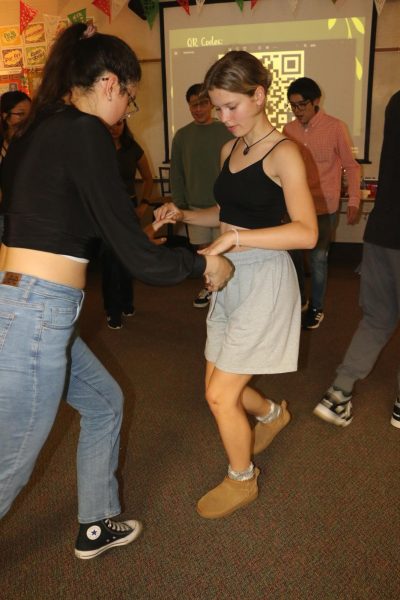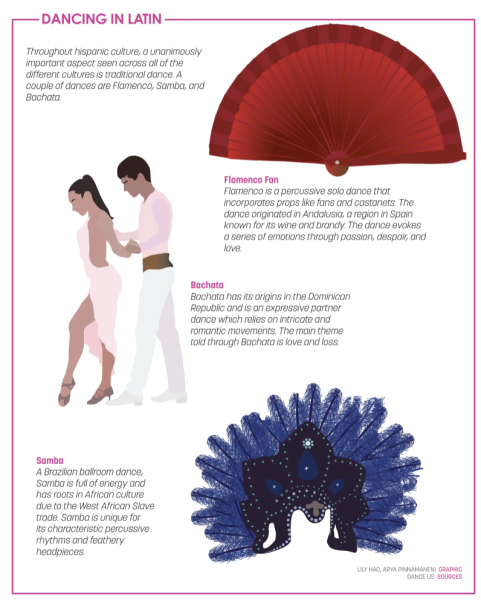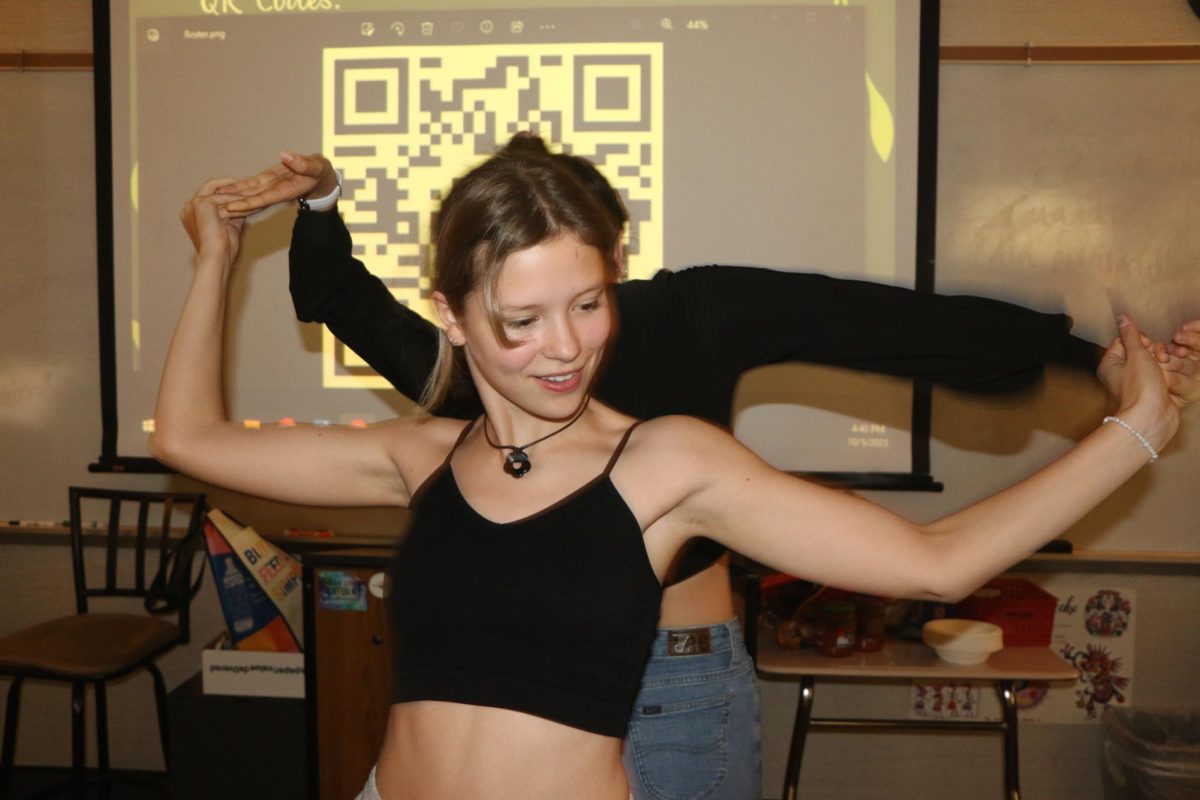According to the U.S. Census Bureau, the Hispanic population in the United States was 63.6 million in 2022, making up around 19% of the U.S. population.
However, despite the size of that population, senior Martina Queijo, who moved to the United States from Argentina when she was 4 years old, said finding ways to keep connections to her heritage has been difficult.
“I have had kind of a cultural disconnect from where I’m really from and (how I can) keep my Spanish intact, or what I do to connect with the Latin community. When I was younger, I almost felt like an imposter, and I (sometimes felt like) I wasn’t really Latina,” Queijo said.

Senior Ana Maria Useche Caicedo, who moved from Colombia during her sophomore year, said she experiences similar struggles, especially at this school.
“At school, I know a couple of Latin-American kids, (but) I wasn’t particularly connected to them because I’m not ‘stereotypically Latin-American’, like, I’m tall, I’m white, I don’t have that much of an accent when I speak,” Useche Caicedo said.
In an effort to strengthen her connection with her heritage, Queijo said she started the Latinx Student Alliance (LSA). Queijo said the LSA made exploring her heritage easier.
“One of the main ways that I maintain my Latin heritage is by running (the LSA),” she said. “Every other Thursday, we meet and do cultural exchanges, so I’m able to talk a lot about who I am as an Argentinian.”
Similarly, Useche Caicedo said the LSA helps individuals who feel disconnected from their heritage to learn more about being Latin American.
“I think it provides a nice community, particularly because a lot of kids who went are kids who have Hispanic parents but weren’t born in a Latin American place themselves,” Useche Caicedo said. “Here are people who are maybe only half connected to their heritage, or maybe have never been to Latin America despite their parents being very much Latin American, so they want to connect with that. I see LSA that way, like as a place to try to connect with people, and a place to invite people who haven’t been exposed to Latin American culture.”
September 15 through Oct. 15 marked Hispanic Heritage Month, and Queijo and Useche Caicedo said they wanted to continue to emphasize the importance of having a month dedicated to exploring Hispanic heritage.
Queijo said Hispanic Heritage Month was and continues to be a good opportunity to explore the impact of Hispanic individuals within the United States.
“Hispanic Heritage Month really brings people back to the importance of the Latin community in the United States,” she said. “As you look back and see really prevalent Latin figures in US history, or in any country’s history, it’s really important to look back and see how our community has played a key role in that.”
To add on, Useche Caicedo said she feels appreciated by the rest of the community during Hispanic Heritage Month.
“It just feels nice, (because) you’re like, ‘Oh my gosh, that’s me I know about that,’” she said. “Something we did with the club was we hung up posters a while ago with recommendations for traditional Latin American foods and restaurants here in Carmel. It’s a really big highlight to see how the school will give you money to do an initiative to promote your culture.”
Spanish teacher Rebecca McBride said, although she is not Hispanic, she enjoys learning more about Hispanic culture during Hispanic Heritage month.
“I (especially) enjoy learning languages, and the reason I enjoy learning languages is because it unlocks this whole world (you didn’t have access to before),” McBride said.
Useche Caicedo said the best way for non-Hispanics such as McBride to learn about Hispanic heritage and culture is by being open-minded.
“A lot of students in Spanish don’t want to try and pronounce things correctly because (they) don’t want to seem racist, but it’s really way worse when you don’t care about it,” she said. “Be genuine about it, like if you don’t care? Tough, you don’t care. But if you do want to (learn), go in with an open mind. Try a new food, listen to a new artist, go to a dance class, you can really immerse yourself in it, it doesn’t have to be about anything other than curiosity.”

McBride said she also has activities for her students to participate in during class so they can learn more about Hispanic culture.
“I teach students about Hispanic culture in my classes, sometimes in small ways like talking about how school schedules are different in Ecuador than they are here at CHS, (but) sometimes we take more time to experience culture, for instance by putting together our own version of a quinceanera and by having tortilla day,” McBride said.
In addition, McBride said while Spanish classes always have elements of Hispanic culture and heritage within the curriculum, she learned more by having real experiences with Hispanic people.
“Learning about Hispanic culture is integrated into all Spanish classes, but really, it was going (to different places), meeting people and getting to know them that was the most significant (experience with Hispanic culture) for me,” she said.
Queijo said she agreed, and that non-Hispanics can learn best from their Hispanic peers.
“I think a (really good way) you can learn about Hispanic heritage is really by reaching out to your friends and finding out about different cultural practices,” she said. “I think everybody has their own little thing—in my house, I eat empanadas basically every day—but everybody has their own thing that makes up their culture. Learning from your friends’ experiences, learning about those really unique cultural aspects is, I think, the best way to (learn more about Hispanic heritage).”
Ultimately, Queijo said she wants more people to recognize the impact of Hispanic culture and heritage on both Hispanics and the general population.
“It’s important for the school and people (outside) of the community to realize that Latin culture and heritage is so important to so many people,” Queijo said. “It makes up most of my life, it makes up a lot of these people’s lives, especially at home, and a lot of times that’s not reflected at school. Seeing people honor Hispanic heritage (in different ways) is really important for Hispanics to see their identity reflected in the community.”































![What happened to theater etiquette? [opinion]](https://hilite.org/wp-content/uploads/2025/04/Entertainment-Perspective-Cover-1200x471.jpg)














































![Review: “The Immortal Soul Salvage Yard:” A criminally underrated poetry collection [MUSE]](https://hilite.org/wp-content/uploads/2025/03/71cju6TvqmL._AC_UF10001000_QL80_.jpg)
![Review: "Dog Man" is Unapologetically Chaotic [MUSE]](https://hilite.org/wp-content/uploads/2025/03/dogman-1200x700.jpg)
![Review: "Ne Zha 2": The WeChat family reunion I didn’t know I needed [MUSE]](https://hilite.org/wp-content/uploads/2025/03/unnamed-4.png)
![Review in Print: Maripaz Villar brings a delightfully unique style to the world of WEBTOON [MUSE]](https://hilite.org/wp-content/uploads/2023/12/maripazcover-1200x960.jpg)
![Review: “The Sword of Kaigen” is a masterpiece [MUSE]](https://hilite.org/wp-content/uploads/2023/11/Screenshot-2023-11-26-201051.png)
![Review: Gateron Oil Kings, great linear switches, okay price [MUSE]](https://hilite.org/wp-content/uploads/2023/11/Screenshot-2023-11-26-200553.png)
![Review: “A Haunting in Venice” is a significant improvement from other Agatha Christie adaptations [MUSE]](https://hilite.org/wp-content/uploads/2023/11/e7ee2938a6d422669771bce6d8088521.jpg)
![Review: A Thanksgiving story from elementary school, still just as interesting [MUSE]](https://hilite.org/wp-content/uploads/2023/11/Screenshot-2023-11-26-195514-987x1200.png)
![Review: "When I Fly Towards You", cute, uplifting youth drama [MUSE]](https://hilite.org/wp-content/uploads/2023/09/When-I-Fly-Towards-You-Chinese-drama.png)
![Postcards from Muse: Hawaii Travel Diary [MUSE]](https://hilite.org/wp-content/uploads/2023/09/My-project-1-1200x1200.jpg)
![Review: "Ladybug & Cat Noir: The Movie," departure from original show [MUSE]](https://hilite.org/wp-content/uploads/2023/09/Ladybug__Cat_Noir_-_The_Movie_poster.jpg)
![Review in Print: "Hidden Love" is the cute, uplifting drama everyone needs [MUSE]](https://hilite.org/wp-content/uploads/2023/09/hiddenlovecover-e1693597208225-1030x1200.png)
![Review in Print: "Heartstopper" is the heartwarming queer romance we all need [MUSE]](https://hilite.org/wp-content/uploads/2023/08/museheartstoppercover-1200x654.png)



